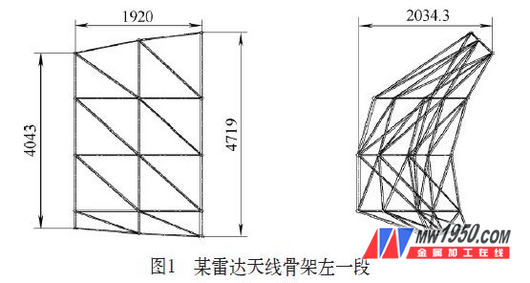1 Overview
The size of a radar antenna is 12 000mm × 5000mm (length × width). It is a large force-receiving piece welded by a titanium alloy pipe with a wall thickness of 3 to 6mm into a truss structure. It is assembled in five pieces. In order to reduce the weight of the radar antenna, meet the mobility index of its rapid erection, and improve the corrosion resistance of the product, the antenna frame adopts a titanium alloy pipe and a welded form of the plate. Since the antenna frame needs to withstand 12 wind loads and the gravity of the antenna and the inertial force of the antenna rotation, how to solve the welding of titanium alloy is the key to the success of the antenna frame.
2. Titanium alloy welding difficulties
The welding of titanium alloys has always been a difficult problem in the welding process, which is caused by the following reasons.
(1) Titanium has high chemical activity, and it is easily contaminated by air, moisture, grease, oxide film, etc., even in a molten state at a high temperature of 400 ° C or higher, absorbing oxygen, nitrogen, hydrogen, carbon and other impurities. The plasticity and toughness of the welded joint are significantly reduced, and the pores are easily caused. Therefore, it is necessary to protect not only the molten pool and the weld bead, but also the part with a temperature of ≥400 °C near the welded part.

(2) Since titanium has a high melting point, a large heat capacity, and poor thermal conductivity, the welded joint tends to cause grain growth, which causes a decrease in joint plasticity, so the heat input to the weld is strictly controlled. In addition, a small current, fast soldering method is used.
(3) Due to the hydrogen and welding residual stress, the titanium material is liable to cause cold cracking during welding, so the hydrogen content of the welded joint is controlled. In addition, for complex welded structures, stress relief treatment after welding is required.
(4) The elastic modulus of titanium is half that of steel, so the welding deformation is large, and correcting the deformation will be quite difficult.
For more information, please refer to the attachment or read the contents of the 18th issue of Metalworking (Hot Processing).
Boiler And Pipeline Insulation Rock Wool Board
Boiler And Pipeline Insulation Rock Wool Board can prevent heat loss, and Yu Ou Nuo Rated Rock Wool For Boiler has superior thermal insulation performance, which greatly improves the energy-saving performance of the system. Yu Ou Nuo Rock Wool Insulation is suitable for refractory insulation of various boilers, mining machinery, drying equipment, etc. Yu Ou Nuo Rock Wool Insulation has the advantages of low thermal conductivity, high operating temperature, fireproof and non-combustible, convenient construction and high performance-price ratio. It can be used for heat preservation, energy saving and anti-freezing of various pipelines.
Rated Rock Wool For Boiler,Sound Absorption Steam Boiler Thermal Insulation Rock Wool,Rock Wool Insulation,Rock Wool Board
Zhengzhou Ou Nuo Building Materials Co., Ltd. , https://www.jcyuounuo.com